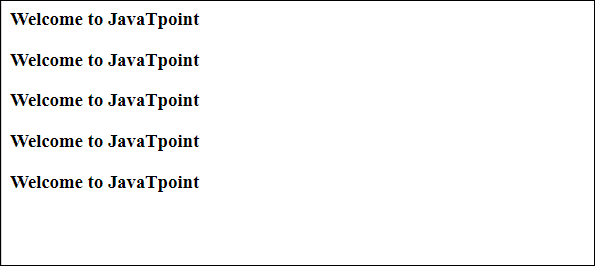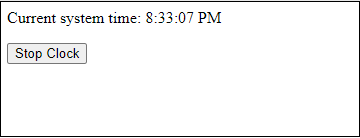JavaScript 计时器
在JavaScript中,计时器被用来在特定时间执行任务或任何函数。基本上,计时器用于延迟程序的执行或以规律的时间间隔执行JavaScript代码。借助计时器,我们可以延迟代码的执行。因此,当事件触发或页面加载时,代码不会立即完成执行。
计时器的最佳示例是网站上的广告横幅,它们每隔2到3秒钟就会变化一次。像亚马逊这样的网站会在一定的时间间隔内更换广告横幅。我们设置一个时间间隔来更换它们。在本章中,我们将展示如何创建计时器。
JavaScript提供了两个计时器函数 setInterval() 和 setTimeout() ,它们可以延迟代码的执行,并允许执行一个或多个操作。我们将详细讨论这两个计时器函数,以及它们的示例。
示例
以下是使用这些函数的JavaScript计时器的一些示例。
setTimeout()
setTimeout()函数帮助用户延迟代码的执行。setTimeout()方法接受两个参数,其中一个是用户定义的函数,另一个是延迟执行的时间参数。时间参数以毫秒为单位(1秒 = 1000毫秒),可选传递。
setTimeout()的基本语法如下:
setTimeout(function, milliseconds)
我们将使用setTimeout()函数来延迟3秒后打印消息。消息将在代码执行后的3秒显示在网页上,而不会立即显示。现在,让我们看一下下面的代码,看看它是如何工作的:
延迟后执行代码
<html>
<body>
<script>
function delayFunction() {
//display the message on web after 3 seconds on calling delayFunction
document.write('<h3> Welcome to JavaTpoint <h3>');
}
</script>
<h4> Example of delay the execution of function <h4>
<!?button for calling of user-defined delayFunction having 3 seconds of delay -->
<button onclick = "setTimeout(delayFunction, 3000)"> Click Here </button>
</body>
</html>
输出
上面的代码将分两部分执行。首先,代码的HTML部分将会执行,在点击 Click Here 按钮之后,剩余的JavaScript代码将在3秒后执行。请见下方输出:

点击 点击这里 按钮后,剩余的代码将在3秒后执行。在3秒后(3000毫秒),网页上将显示一条消息: 欢迎来到javaTpoint 。

setInterval()
setInterval方法跟setTimeout()函数有点类似。它会在一段时间间隔之后重复执行指定的函数。也可以简单地说,一个函数在该函数中提供的特定时间间隔后重复执行。 例如 – 每五秒钟显示更新后的时间。
setInterval()的基本语法是:
setInterval(function, milliseconds)
与setTimeout()方法类似,它也接受两个参数,其中一个是用户自定义的函数,另一个是在执行函数之前等待的时间间隔参数。时间间隔参数表示以毫秒为单位的时间量(1秒 = 1000毫秒),可选择传递。现在,看一下下面的代码,了解这个函数的工作原理:
在固定时间间隔内执行代码
<html>
<body>
<script>
function waitAndshow() {
//define a date and time variable
var systemdate = new Date();
//display the updated time after every 4 seconds
document.getElementById("clock").innerHTML = systemdate.toLocaleTimeString();
}
//define time interval and call user-defined waitAndshow function
setInterval(waitAndshow, 4000);
</script>
<h3> Updated time will show in every 4 seconds </h3>
<h3> The current time on your computer is: <br>
<span id="clock"></span> </h3>
</body>
</html>
输出
在执行上述代码时,响应将是一个简单的HTML语句,没有任何时间字符串,如下所示的输出:

在4秒钟后,JavaScript函数将调用并开始显示时间。这将每隔四秒钟重复显示您的系统时间。

示例
setInterval() 方法的另一个示例,每隔4秒连续显示一个消息字符串。
<html>
<body>
<script>
function waitAndshow() {
//display the message on web on calling delayFunction
document.write('<h3> Welcome to JavaTpoint <h3>');
}
</script>
<h3> A string will show in every 4 seconds </h3>
<!-- call user-defined delayFunction after 4 seconds -->
<button onclick = "setInterval(waitAndshow, 4000)"> Click Here </button>
</body>
</html>
输出
在执行上述代码时,浏览器将显示一个带有按钮的消息。点击该按钮以进行更多处理并查看接下来会发生什么。

点击这个 点击这里 按钮,waitAndShow()函数将会每4秒在网页上重复打印 欢迎来到Javatpoint 这条信息。

您已经看到了如何创建计时器或设置时间间隔。有时候,我们需要取消这些计时器。JavaScript提供了内置函数来清除计时器,如下所示:
取消或停止计时器
JavaScript提供了两个函数 clearTimeout() 和 clearInterval() 来取消或停止计时器并停止代码的执行。setTimeout()和setInterval()都会返回一个唯一的ID。这些ID由clearTimeout()和clearInterval()使用,用于清除计时器并在代码执行之前停止。它们只接受一个参数,即ID。
示例
在这个示例中,我们将使用clearTimeout()来清除由setTimeout()函数设置的计时器。看看clearInterval()如何与setInterval()一起工作。
禁用定期间隔
<html>
<body>
<script>
function waitAndshow() {
//define a date and time variable
var systemdate = new Date();
//display the updated time after every 4 seconds
document.getElementById("clock").innerHTML = systemdate.toLocaleTimeString();
}
//function to disable the time interval
function stopClock() {
clearInterval(intervalID);
}
//define time interval and call user-defined waitAndshow function
var intervalID = setInterval(waitAndshow, 3000);
</script>
<p>Current system time: <span id="clock"> </span> </p>
<!-- button to stop showing time in a regular interval -->
<button onclick = "stopClock();" > Stop Clock </button>
</body>
</html>
输出
通过执行上述代码,当前系统时间将以3秒的规律间隔显示在网页上。此页面还有一个按钮可以禁用这个计时器。

每三秒钟,计时器将显示更新后的时间。如果您点击这个 停止计时器 按钮,计时器将被禁用并停止显示更新的时间。

 极客笔记
极客笔记